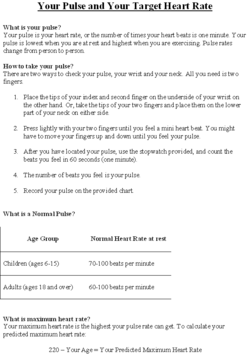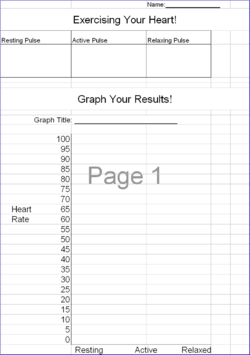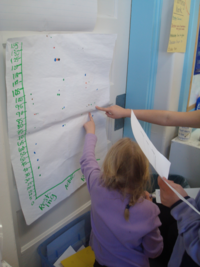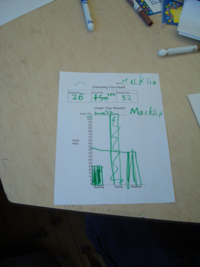Exercising the heart
| Instant wiki maker | Making handouts | Editing tips |
Biology In Elementary Schools is a Saint Michael's College student project from a course that ran between 2007 and 2010 and fully described in this book chapter. The student-created resources have been preserved here for posterity. Link under 'toolbox' for printer-friendly versions of the exercises. Click on handouts to print full resolution versions. Please see Wikieducator's disclaimer, our safety statement, and the Creative Commons licensing in English and in legalese.
Student worthiness
Tried and Trusted
Primary biological content area covered
- Human Body & Health
- The heart and pulse
Materials
- Stopwatch
- Pulse and Target Heart Rate Handout
- Exercising Your Heart Handout
Handouts
Students will receive two handouts. One handout will explain to the students what a pulse is and how to find a pulse. The second handout is a place where students can record their personal data and graph their results.
Description of activity
Students will measure and record their pulse on 3 seperate occasions: after 60 seconds of relaxing, 60 seconds of rigorous exercise, and 60 seconds of deep breathing. After they've finished the 3 experiments, they will record their results on a graph and observe the differences in their pulse.
Lesson plan
- Explanation of heart rate and pulse. What is it? Why is it important? Use a hand out with visuals to help students understand how to find their pulse.
- Have students sit quietly for 60 seconds to relax their pulse rate.
- Once students have relaxed, have them find his or her pulse.
- Have students count their pulse for 60 seconds.
- After the 60 seconds each student should record their results on the chart provided.
- Now have students spread out and lead them in 60 seconds of cario exercise.(jumping jacks, jogging in place, skipping, etc.)
- After the 60 seconds of exercise, have each student again, find his or her pulse.
- Have them count how the number of beats, like before. Do this for 60 seconds.
- Have students record their results on the chart provided.
- Finally lead the students in 60 seconds of deep breaking to relax their pulse.
- After the deep breathing exercise have students take and record their pulse for the last time.
- Students should have recorded their pulse from the 3 exercises on the individual chart given to them.
- Once students have completed the activity have them plot their results on the graph made prior to the experiment. After each student has put their results on the graph, go over the graph to observed the differences in pulse rate based on the activities the students participated in.
Potential pitfalls
- Students may not be able to find their pulse.
- Studets may misscount their pulse beats.
Math connections
There are several math connections that can be included in this activity. The students will be counting their pulse and keeping track of their heart rate. After students have collected all the data, they will be graphing their results and comparing their heart rates through the three activities that were carried out. Older students can use the data collected to practice finding the mean, median and mode to further analyze the data.
Literature connections
Literature plays a very important role in the enhancement of student learning. It is imporatnt to find ways to tie literature in with science whenever possible. For this activity a great book to read would be, Hear Your Heart by Paul Showers. Hear Your Heart is a childrens book that describes how the heart works and how to find its beat! It also talks about the importance of exercise and why you need to keep your heart healthy! Keep your students informed by reading this fun, illustrated book!
Find this book:
Showers, Paul. Hear Your Heart. HaperCollins 2001
Connections to educational standards
S1-2:6 Students demonstrate their ability to analyze data by…
- Identifying and describing the pattern in diagrams and charts (e.g., model, bar graph, pictograph, diagram or chart ).
S5-6:41 Students demonstrate their understanding of Human Body Systems by…
- Investigating circumstances that affect more than one body system and explaining the interconnected relationship between the body systems (e.g., the effects of exercise on several interdependent body systems, such as respiratory, circulatory, digestive, nervous, skeletal systems).
Next steps
This could be used as an introduction to the circulatory system. You may also give each student a stopwatch and ask them to record their pulse at various times throughout the course of 2 or 3 days (e.g. when they wake up, after a sports game, after playing tag, etc.). Students will record their pulse and make their own graph (similar to the one used in class). They can then share their graphs with the rest of the class.
Reflections
Overall, the lesson was a success. The students enjoyed the activity but the only problem was that some had difficulty finding their pulse. We recommend that students have time to practice finding their pulse before jumping into the activity. It was clear that some students decided on a random number, as some resting pulses were 20 beats per minute. The students were all interested in participating, but with more background knowledge, they would have been better able to find an accurate pulse.
Citations and links
This site was useful for making out handouts.




